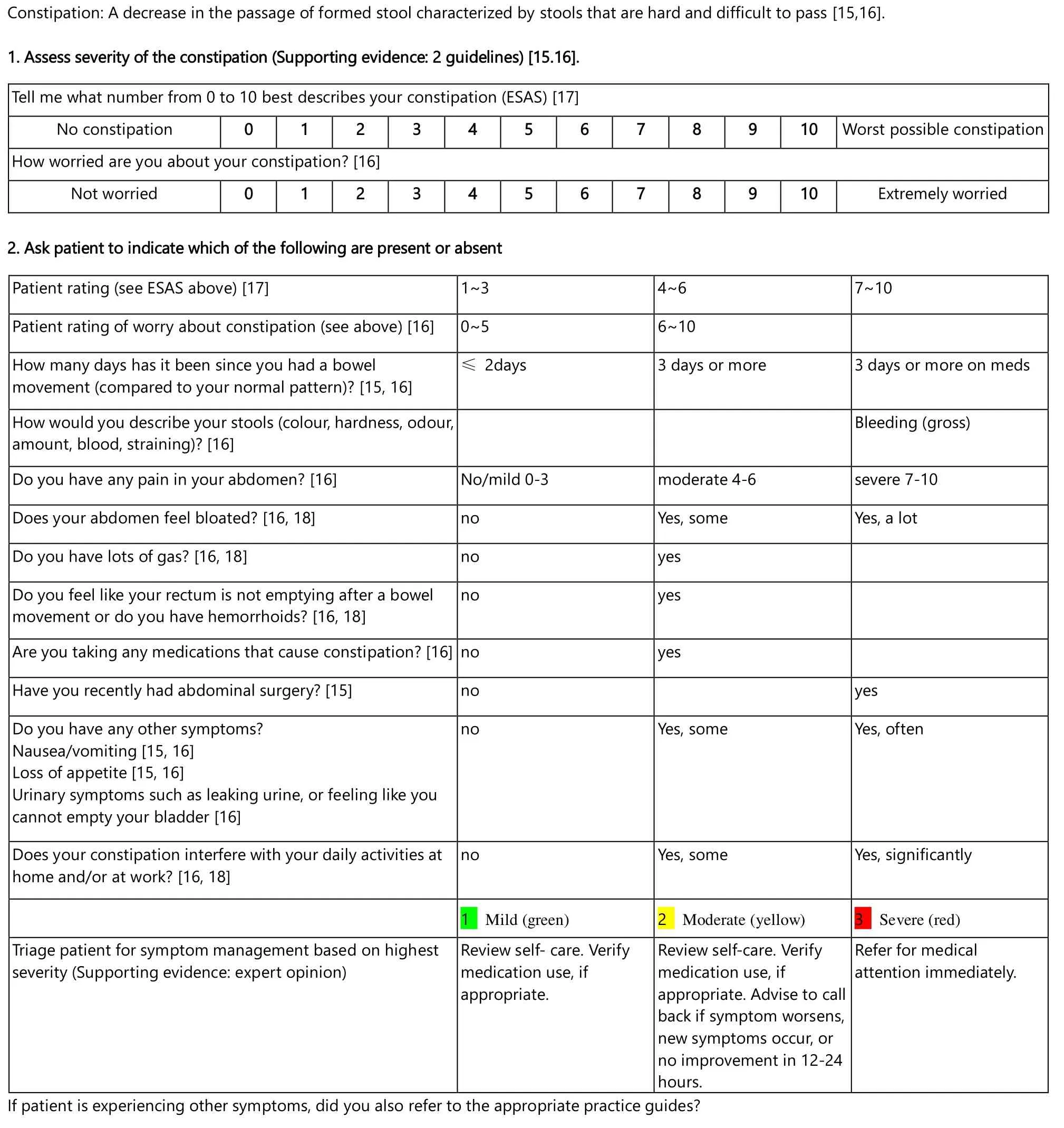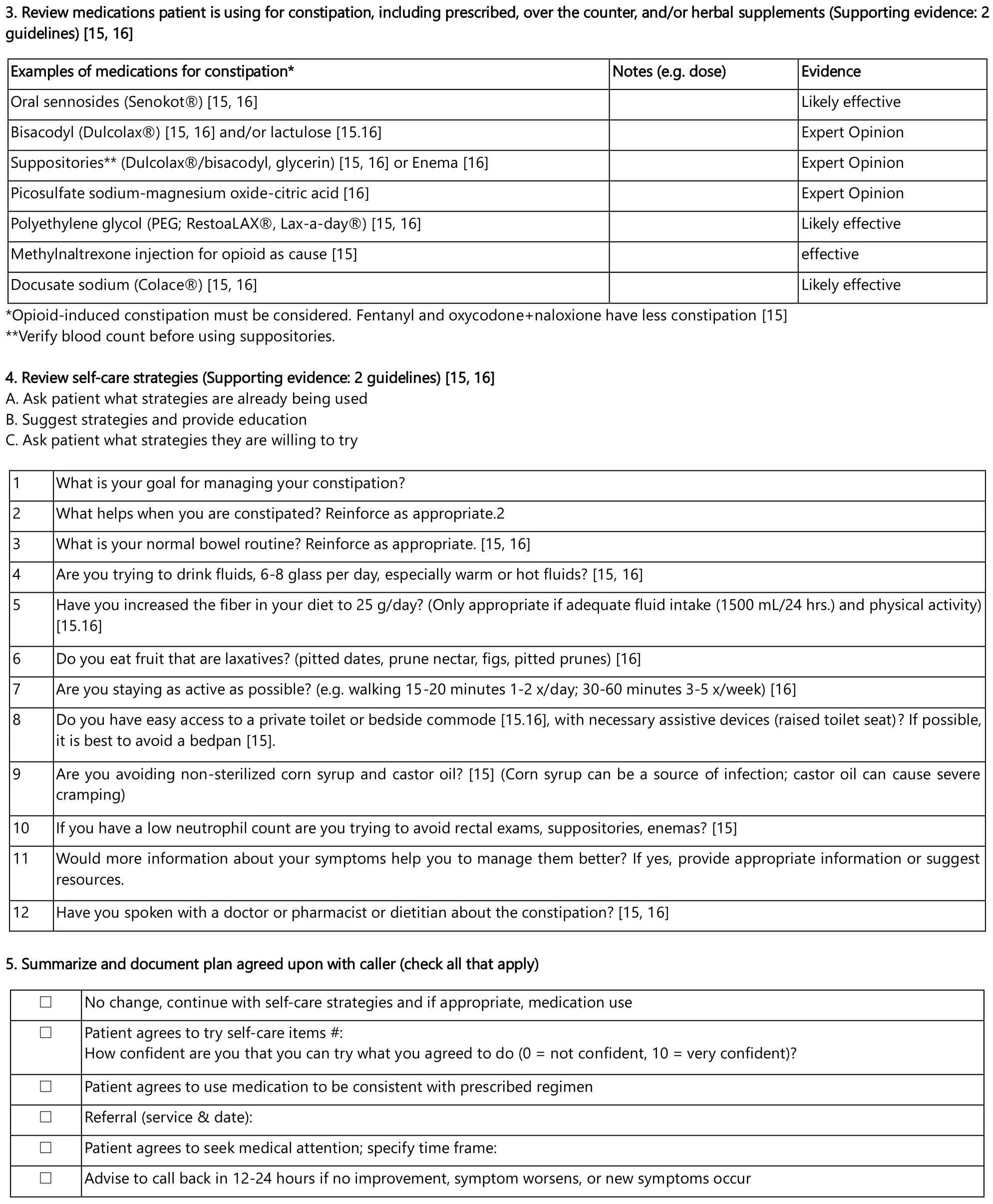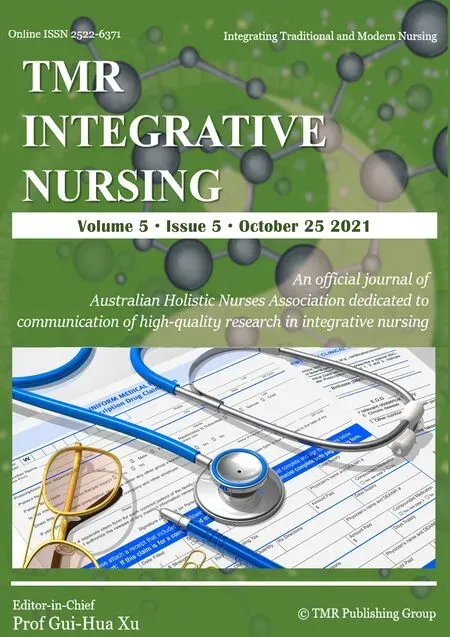A brief introduction of the pan-Canadian Oncology Symptom Triage and Remote Support (COSTaRS) project
Xue-Jing Li, Ke Peng, Qiu-Lu Mai, Xiao-Yan Zhang, Yu-Fang Hao*
1 School of Nursing, Beijing University of Chinese Medicine, Beijing, China.
2 Beijing University of Chinese Medicine Collaborating Centre of Joanna Briggs Institute, Beijing, China.
3 Beijing University of Chinese Medicine Best Practice Spotlight Organization, Beijing, China.
Abstract:Because of the long-term and phased nature of tumor’s treatment, most tumor patients need to survive with cancer for a long time.The remote management of tumor-related symptoms has become a problem that needs to be solved urgently in the clinic.However, due to the lack of relevant guidance and specifications, the remote management of tumor symptoms in China still faces many obstacles.Learning from mature and successful tumor symptom remote management projects abroad is the only way to improve China's remote management norms.Therefore, this article will introduce the Canadian tumor symptom remote management project and its constipation symptom management guide, and provide a guide for the development of tumor symptom remote management projects in China reference.
Keywords:Cancer, Symptom, Management, Canada, Constipation, Practice guideline
Introduction
According to the World Health Organization (WHO), cancer is the second leading cause of death worldwide [1].In view of the long-term and phasic nature of cancer treatment, patients need to receive two scenarios: in-hospital treatment and out-of-hospital disease self-management.During the hospital period, the patient's symptoms can generally be promptly instructed and well controlled.However, during the out-of-hospital period, the patient's symptom-induced factors are prone to be replaced, the early symptoms are not corrected and identified, the symptoms are not managed promptly, and the symptoms are not handled properly.Symptom self-management is ineffective [2].The remote management of symptoms is becoming more and more widely used in the management of chronic diseases, and it plays an active role [3, 4], which provides an opportunity for timely and effective self-management of symptoms related to cancer patients.Among them, the pan-Canadian Oncology Symptom Triage and Remote Support (COSTaRS), developed and completed by the National Cancer Steering Committee of Canada, has been implemented for 12 years, and has gradually achieved better results throughout Canada [5].The research team has experienced early research and believes that a reasonable project in China can help solve the dilemma of remote management of cancer patients in China.
Therefore, we signed a project authorization with the team and plan to promote this project in China.The following is an introduction to this project.
Project Overview
The pan-Canadian Oncology Symptom Triage and Remote Support (COSTaRS) project was developed and implemented by the Canadian National Oncology Steering Committee, with funding from the canadian cancer cooperation organizations.The contents of the project mainly include: guidelines for remote management of oncology symptoms, guidelines for the application of nurse training materials, evaluation tools for guideline application process indicators and outcome indicators, and related publications issued by the COTaRS team.The above information can be obtained through the COSTaRS project official website at: https://ktcanada.ohri.ca/costars/ Research/
Introduction to Clinical Practice Guide of Oncology Symptom Remote Management
High quality remote symptom management requires the use of symptom practice guidelines to reduce risk, which is the core content of this project [6, 7].The development team of practice guide is: COTaRS Steering Committee, including researchers, information system researchers, librarians, senior practicing nurses and nursing leaders.In 2013, Professor Dawn Stacey led COTaRS team to build 13 user-friendly symptom practice guidelines based on the knowledge transformation model.The construction process of the guidelines is consistent with that of evidence-based guidelines.The guidelines were updated in 2016 and 2 new symptom practice guidelines were added, and will be updated again in 2020.Each symptom practice guide adopts the adapt method to adapt the existing guidelines related to cancer symptom grading management [8-10], and assists nurses and patients in symptom remote management according to the five steps of assessing symptom severity, symptom grading management, reviewing drug use, reviewing self-care strategy and summarizing and recording the plan agreed with patients for continuous monitoring.In addition, we have identified more than 40 practical guidelines in total and evaluated their quality using the agree tool (ranging from 8% to 87%) [11].The evaluation results show that the potential bias in the development of the guidelines is small, and the effectiveness (internal and external) and feasibility of the recommendations of the guidelines are high [12].According to the symptom practice guide, nurses mainly use the form of telephone and email to carry out symptom remote management on patients [13].Professor Stacey [14] showed that 51% of nurses used these symptom practice guidelines, and found that the implementation has achieved varying degrees of success, and further support is needed to strengthen the use of symptom practice guidelines.
At present, the project includes 15 clinical practice guidelines for oncology symptom management: anxiety practice guidelines, appetite loss practice guidelines, bleeding practice guidelines, breathlessness/ dyspnea practice guidelines, constipation practice guidelines,depression practice guidelines, diarrhea practice guidelines, fatigue/tiredness practice guidelines, febrile neutropenia practice guidelines, mouth sores/stomatitis practice guidelines, nausea and vomiting practice guide, pain practice guide, peripheral neuropathy practice guide, skin reaction practice guide under and sleep problems practice guide.
Content of constipation symptom management practice guideline
This paper will take the remote management guide of cancer constipation symptoms in COSTaRS project as an example to show the contents of the guideline.(in addition to the following contents, the guide also includes the explanation of symptoms, and leaves room for recording the personal information of patients and the application time of the guide).The construction and application mode of the remaining 14 practical guides are the same as that of this guide It can be used directly by clinical nurses.Four other guidelines [15-18] have been referred for the development of this practical guide for constipation.
Related Research Tools

Constipation Practice Guide

3.Review medications patient is using for constipation, including prescribed, over the counter, and/or herbal supplements (Supporting evidence: 2 guidelines) [15, 16] Examples of medications for constipation* Notes (e.g.dose) Evidence Oral sennosides (Senokot?) [15, 16] Likely effective Bisacodyl (Dulcolax?) [15, 16] and/or lactulose [15.16] Expert Opinion Suppositories** (Dulcolax?/bisacodyl, glycerin) [15, 16] or Enema [16] Expert Opinion Picosulfate sodium-magnesium oxide-citric acid [16] Expert Opinion Polyethylene glycol (PEG; RestoaLAX?, Lax-a-day?) [15, 16] Likely effective Methylnaltrexone injection for opioid as cause [15] effective Docusate sodium (Colace?) [15, 16] Likely effective *Opioid-induced constipation must be considered.Fentanyl and oxycodone+naloxione have less constipation [15] **Verify blood count before using suppositories.4.Review self-care strategies (Supporting evidence: 2 guidelines) [15, 16] A.Ask patient what strategies are already being used B.Suggest strategies and provide education C.Ask patient what strategies they are willing to try 1 What is your goal for managing your constipation? 2 What helps when you are constipated? Reinforce as appropriate.2 3 What is your normal bowel routine? Reinforce as appropriate.[15, 16] 4 Are you trying to drink fluids, 6-8 glass per day, especially warm or hot fluids? [15, 16] 5 Have you increased the fiber in your diet to 25 g/day? (Only appropriate if adequate fluid intake (1500 mL/24 hrs.) and physical activity) [15.16] 6 Do you eat fruit that are laxatives? (pitted dates, prune nectar, figs, pitted prunes) [16] 7 Are you staying as active as possible? (e.g.walking 15-20 minutes 1-2 x/day; 30-60 minutes 3-5 x/week) [16] 8 Do you have easy access to a private toilet or bedside commode [15.16], with necessary assistive devices (raised toilet seat)? If possible, it is best to avoid a bedpan [15].9 Are you avoiding non-sterilized corn syrup and castor oil? [15] (Corn syrup can be a source of infection; castor oil can cause severe cramping) 10 If you have a low neutrophil count are you trying to avoid rectal exams, suppositories, enemas? [15] 11 Would more information about your symptoms help you to manage them better? If yes, provide appropriate information or suggest resources.12 Have you spoken with a doctor or pharmacist or dietitian about the constipation? [15, 16] 5.Summarize and document plan agreed upon with caller (check all that apply) □ No change, continue with self-care strategies and if appropriate, medication use □ Patient agrees to try self-care items #: How confident are you that you can try what you agreed to do (0 = not confident, 10 = very confident)? □ Patient agrees to use medication to be consistent with prescribed regimen □ Referral (service & date): □ Patient agrees to seek medical attention; specify time frame: □ Advise to call back in 12-24 hours if no improvement, symptom worsens, or new symptoms occur
During the implementation phase of the project, researchers need to investigate the application of the guidelines before, during and after implementation, and make refer for the purpose of improving the guidelines or designing other strategies to promote the application of the guidelines.During the application of the guideline in Canada, Dr Stacey et al.conducted a series of studies on the application of the guideline and developed the following process and outcome measurement tools: a.Investigating the barrier tools that affect nurses' use of the remote symptom support practice guideline-baseline barrier questionnaire, Obstacle assessment based on planned behavior theory-CPD response questionnaire; b.Patient satisfaction with telephone service-patient satisfaction questionnaire; c.Assessment of training using COSTaRS symptom practice guidelines-training assessment questionnaire; d.Monitoring COTaRS A symptom practice guide to use and assess the outcome of a chart audit-chart audit tool.
Research Prospect
This project has tested the usability of practical guidelines in a cancer nurse community and found them to be easy to read; provide the right amount of information; use appropriate terminology; be suitable for clinical workflow; and have an excellent self-management strategy [19].However, China urgently needs clinical practice guidelines for cancer symptoms that can be embedded in existing workflows and are easy to understand and operate.Therefore, the team plans to introduce this project, localize the content of the guide based on the translation of the guide, and add traditional Chinese medicine nursing related content and evidence support.At the same time, the guideline application steps and application methods (online or telephone) are transformed according to China's existing clinical workflow to create a remote management model for cancer symptoms in China.
- Nursing Communications的其它文章
- Application progress of cognitive behavioral therapy in coronary heart disease
- Methodological quality assessment of meta-analyses of cognitive interventions among Alzheimer's disease
- Effect of lavender aromatherapy on pruritus, anxiety, and sleep quality of patients undergoing hemodialysis: a randomized controlled trial

